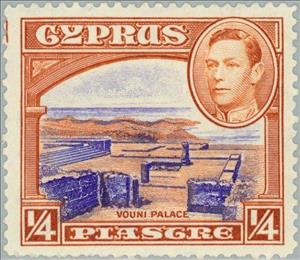Stamp: King George VI & Vouni Palace Ruins (Cyprus 1938)
King George VI & Vouni Palace Ruins (Cyprus 1938)
01 January (Cyprus ) within release Definitives goes into circulation Stamp King George VI & Vouni Palace Ruins face value ¼ Cypriot piastre
| Stamp King George VI & Vouni Palace Ruins in catalogues | |
|---|---|
| Michel: | Mi:CY 136 |
Stamp is horizontal format.
Also in the issue Definitives:
- Stamp - King George VI & Vouni Palace Ruins face value ¼;
- Stamp - King George VI & Ancient Salamis Theatre face value ½;
- Stamp - King George VI & Peristerona Church and Mosque face value ¾;
- Stamp - King George VI & Kyrenia Castle and Harbor face value 1½;
- Stamp - King George VI & Kolossi Castle face value 2½;
- Stamp - King George VI & Map of Cyprus/Coat of Arms face value 4½;
- Stamp - King George VI & Bairakdar Mosque face value 6;
- Stamp - King George VI & Othello's Tower, Famagusta face value 9;
- Stamp - King George VI & Buyuk Khan Inn face value 18;
- Stamp - King George VI & Forest Scene face value 45;
- Stamp - Portrait of King George VI face value 90;
- Stamp - Portrait of King George VI face value 1;
Stamp King George VI & Vouni Palace Ruins it reflects the thematic directions:
A head of state (or chief of state) is the public persona that officially represents the national unity and legitimacy of a sovereign state. In some countries, the head of state is a ceremonial figurehead with limited or no executive power, while in others, the head of state is also the head of government. In countries with parliamentary governments, the head of state is typically a ceremonial figurehead that does not actually guide day-to-day government activities and may not be empowered to exercise any kind of secular political authority (e.g., Queen Elizabeth II as Head of the Commonwealth). In countries where the head of state is also the head of government, the president serves as both a public figurehead and the actual highest ranking political leader who oversees the executive branch (e.g., the President of the United States).
Archaeology or archeology[a] is the study of human activity through the recovery and analysis of material culture. The archaeological record consists of artifacts, architecture, biofacts or ecofacts, sites, and cultural landscapes. Archaeology can be considered both a social science and a branch of the humanities. It is usually considered an independent academic discipline, but may also be classified as part of anthropology (in North America – the four-field approach), history or geography
King is the title given to a male monarch in a variety of contexts. The female equivalent is queen regnant (while the title of queen on its own usually refers to the consort of a king). In the context of prehistory, antiquity and contemporary indigenous peoples, the title may refer to tribal kingship. Germanic kingship is cognate with Indo-European traditions of tribal rulership (c.f. Indic rājan, Gothic reiks, and Old Irish rí, etc.) In the context of classical antiquity, king may translate Latin rex or either Greek archon or basileus. In classical European feudalism, the title of king as the ruler of a kingdom is understood as the highest rank in the feudal order, potentially subject, at least nominally, only to an emperor (harking back to the client kings of the Roman Empire). In a modern context, the title may refer to the ruler of one of a number of modern monarchies (either absolute or constitutional). The title of king is used alongside other titles for monarchs, in the West prince, emperor, archduke, duke or grand duke, in the Middle East sultan or emir; etc. Kings, like other royalty, tend to wear purple because purple was an expensive color to wear in the past.
Ruins (from Latin ruina 'a collapse') are the remains of a civilization's architecture. The term refers to formerly intact structures that have fallen into a state of partial or total disrepair over time due to a variety of factors, such as lack of maintenance, deliberate destruction by humans, or uncontrollable destruction by natural phenomena. The most common root causes that yield ruins in their wake are natural disasters, armed conflict, and population decline, with many structures becoming progressively derelict over time due to long-term weathering and scavenging.




